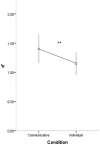Communicative interactions improve visual detection of biological motion
- PMID: 21297865
- PMCID: PMC3027618
- DOI: 10.1371/journal.pone.0014594
Communicative interactions improve visual detection of biological motion
Abstract
Background: In the context of interacting activities requiring close-body contact such as fighting or dancing, the actions of one agent can be used to predict the actions of the second agent. In the present study, we investigated whether interpersonal predictive coding extends to interactive activities--such as communicative interactions--in which no physical contingency is implied between the movements of the interacting individuals.
Methodology/principal findings: Participants observed point-light displays of two agents (A and B) performing separate actions. In the communicative condition, the action performed by agent B responded to a communicative gesture performed by agent A. In the individual condition, agent A's communicative action was substituted with a non-communicative action. Using a simultaneous masking detection task, we demonstrate that observing the communicative gesture performed by agent A enhanced visual discrimination of agent B.
Conclusions/significance: Our finding complements and extends previous evidence for interpersonal predictive coding, suggesting that the communicative gestures of one agent can serve as a predictor for the expected actions of the respondent, even if no physical contact between agents is implied.
Conflict of interest statement
Figures



References
-
- Neri P, Luu JY, Levi DM. Meaningful interactions can enhance visual discrimination of human agents. Nature Neurosci. 2006;9:1186–1192. - PubMed
-
- Nummenmaa L, Calder AJ. Neural mechanisms of social attention. Trends Cogn Sci. 2009;13:135–143. - PubMed
-
- Sebanz N, Bekkering H, Knoblich G. Joint action: bodies and minds moving together. Trends Cogn Sci. 2006;10:70–76. - PubMed
-
- Sebanz N, Knoblich G. Predictions in joint action: What, when, and where. Topics Cogn Sci. 2009;1:353–367. - PubMed

